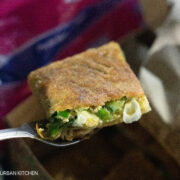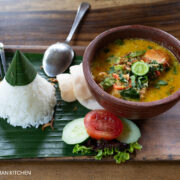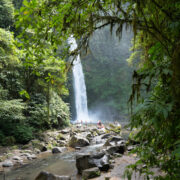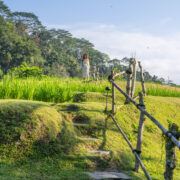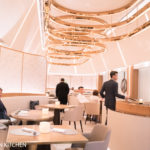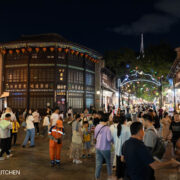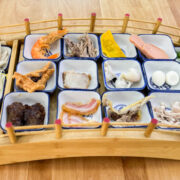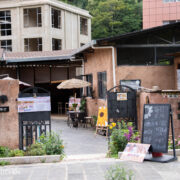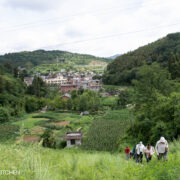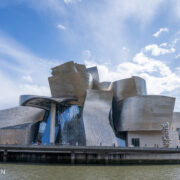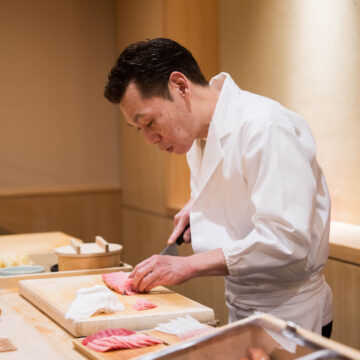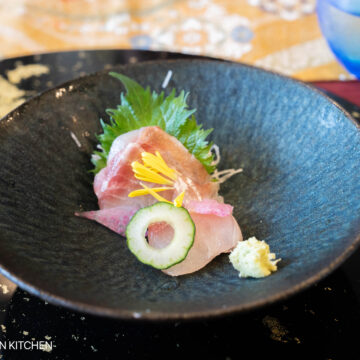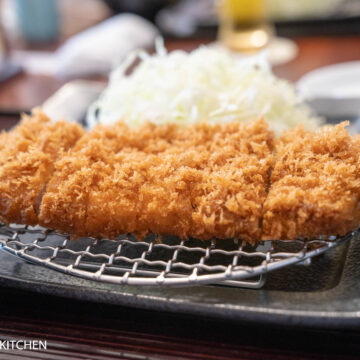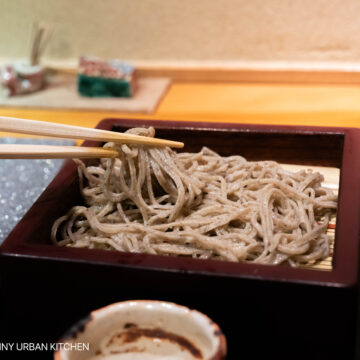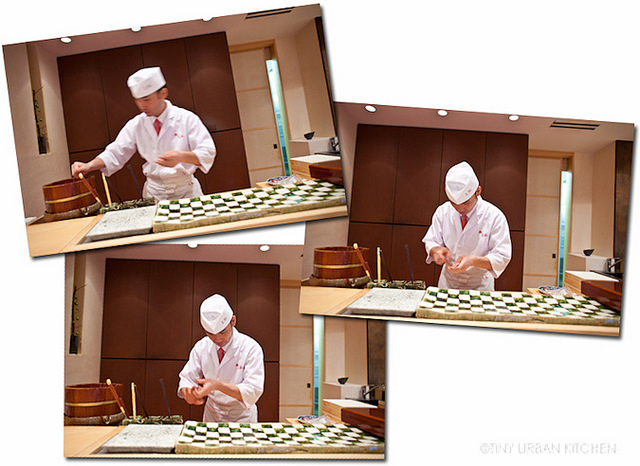
This is part 4 of my latest travel series: Post Quake Japan. Other posts in this series: Kago, Daisan Harumi, and Tempura Kondo.
Following your husband on one of his business trips has both positive and negative aspects.
On the up side, the lodging, his airfare, and his meals are paid by the Company. This particular flight, my million miler husband even used his points to upgrade me to business class with him.
On the down side, however, I'm left to fend for myself for most of the working day and (occasionally), even during the evenings. Sometimes I'll use the time to do some serious clothing (or shoe!) shopping. Other times, I'll visit my favorite kitchen supply area in all of Tokyo.
It was during one of these rainy, working weekdays when I stopped in for lunch at Sushi Mitani.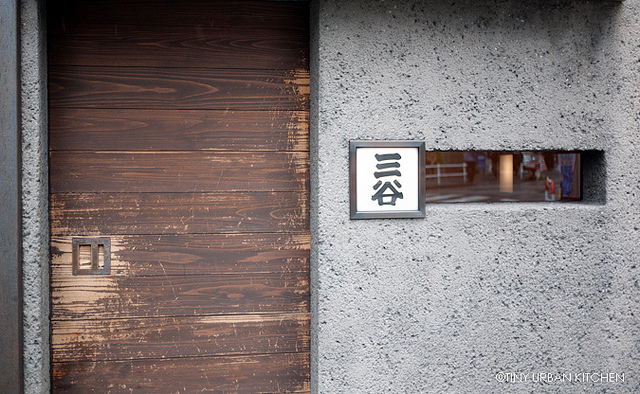
OK, admittedly, "stopped in" is hardly the right term to use. I had made a reservation, partly based on a few glowing reviews online about this place. In fact, I sought out the restaurant, and it was surprisingly difficult to find.
A simple wooden door and a sign written in kanji were my only clues.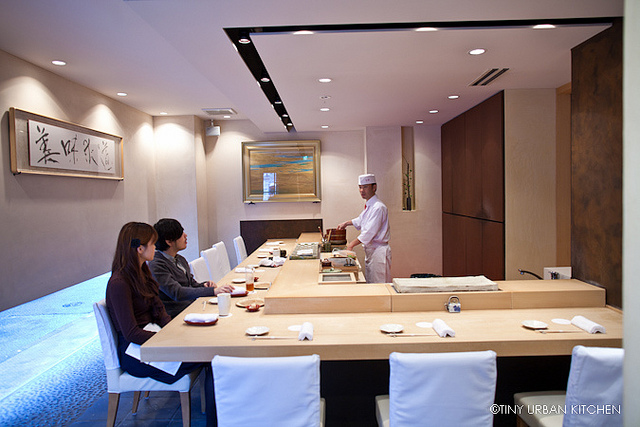
I entered a serene, modern, yet intimate dining space. Like many high-end sushi places, the entire restaurant is merely a sushi bar, manned by the namesake sushi chef himself.
The next two hours were definitely an adventure, both in concepts and in flavor. Instead of your traditional sushi meal consisting almost entirely of unadulterated, fresh seafood with rice, the omakase at Sushi Mitani comes with no shortage of little surprises along the way, many which deviate from the traditional sushi model.
Omakase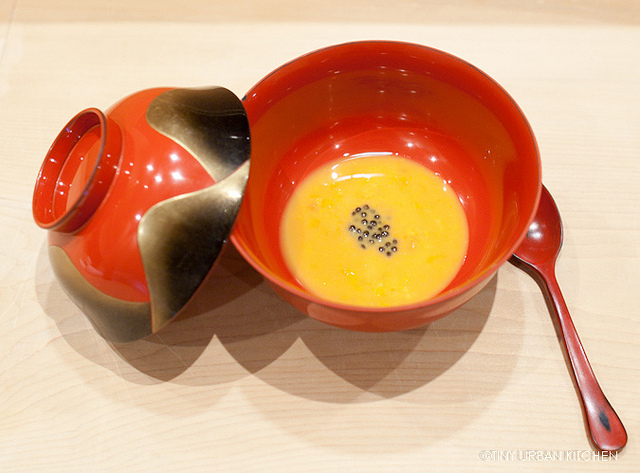
1. Uni (Sea Urchin) Soup
As I settled down into my little sushi bar seat, the sushi chef (Mitani-san himself) welcomed me. I tested my elementary Japanese with him, and he seemed willing to work with me, which immediately put me at ease. Soon after sitting down, he handed me a red lacquered covered bowl.
What could be inside? The traditional miso soup?
I was delighted to discover that I couldn't be more wrong. A vivid orange hue met my eyes. Sweet, creamy, and singing the fresh flavors of uni, this chilled uni and caviar soup was the perfect amuse to what would be an unforgettable meal.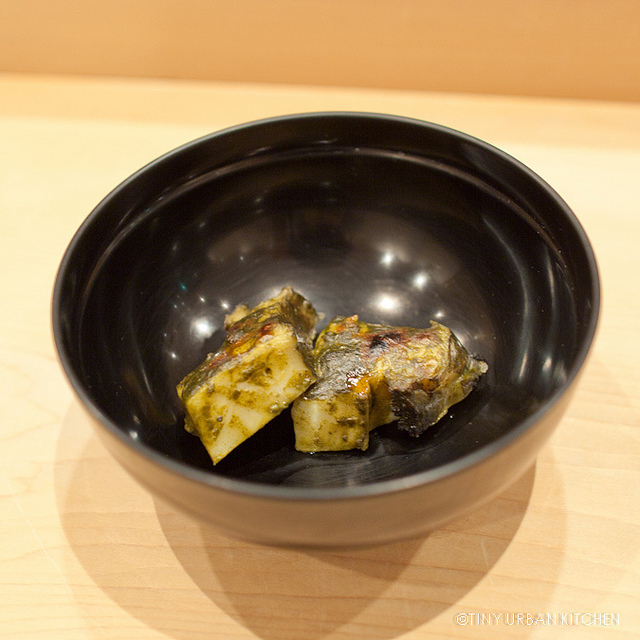
2. Abalone
I then sampled some fresh abalone. This chewy, flavorful shellfish was slightly seared and covered with a seaweed based sauce. Mitani-san told me that the typical season for abalone is May to October, so we were definitely at the tail end of the season.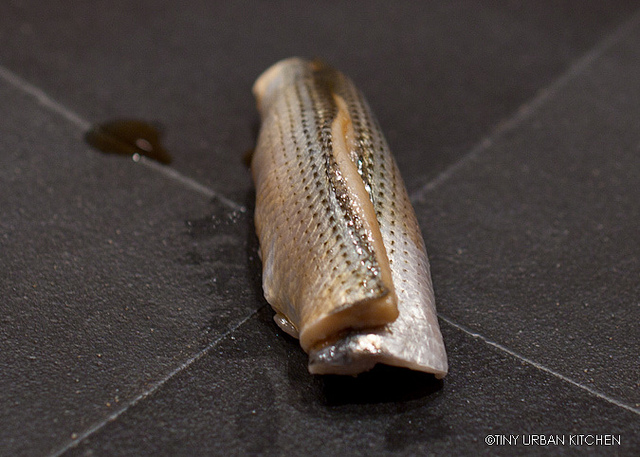
3. Sama
This fatty, mackerel-like fish comes from Hokkaido, is currently in season, and "very delicious" according to Mitani-san. I agreed wholeheartedly - the thick slices of fish were buttery, slightly salty, and full of deep, rich umami.
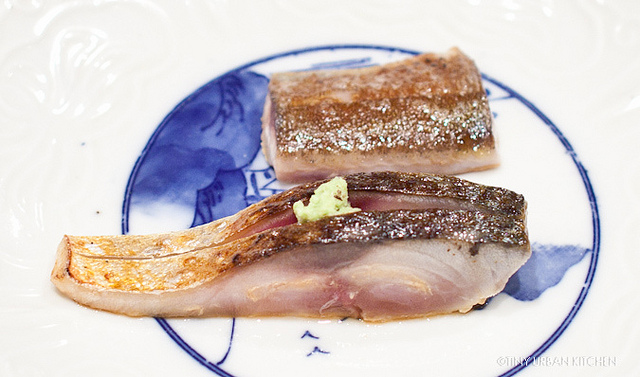
4. Saba (mackerel)
This next course was similarly gorgeous, beautifully rich, and full of flavor. It was so soft that it seemed to melt in your mouth.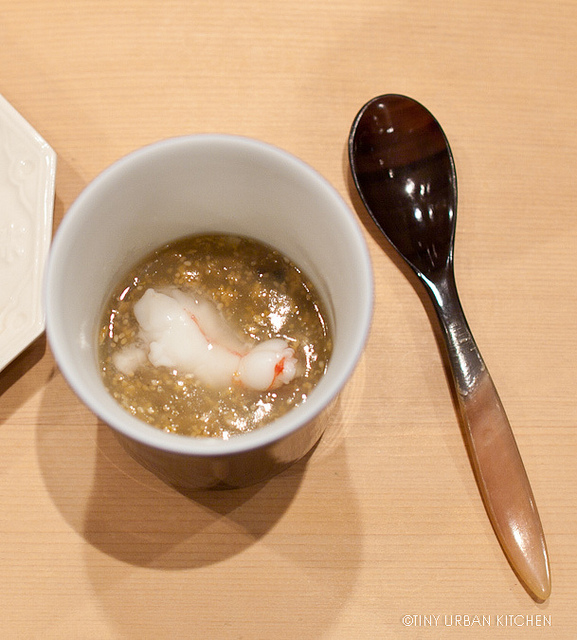
5. Ebi soup with Tamago
After several pieces of sashimi, we had a second course of soup. Here, a perfect, barely-cooked piece of shrimp sat gingerly on top of a thick, almost gelatinous soup filled with shrimp roe. It was rich, and bursting with strong, flavorful umami of the sea.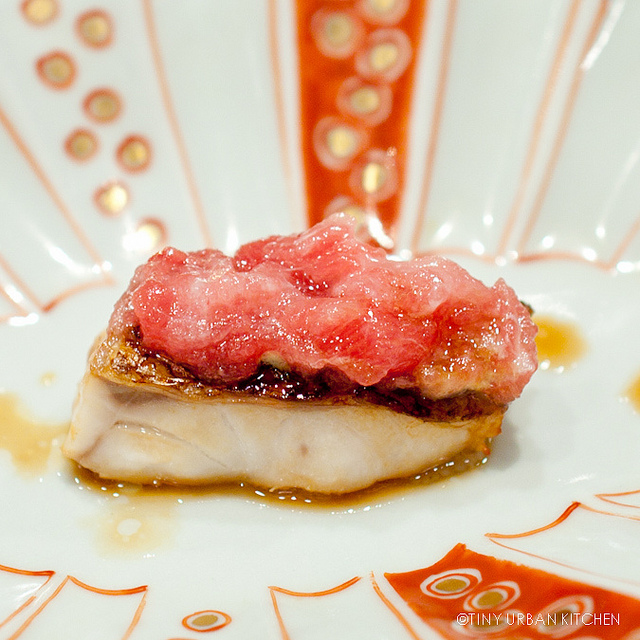
6. Akamatsu with Chutoro
Things continued to get more interesting. Next he handed me this double layered fish course comprising two types of fish: red deep sea grouper on the bottom and fatty tuna (chutoro) on the top. The slightly seared grouper was sweet while the fatty tuna was rich and fatty. It was an interesting contrast.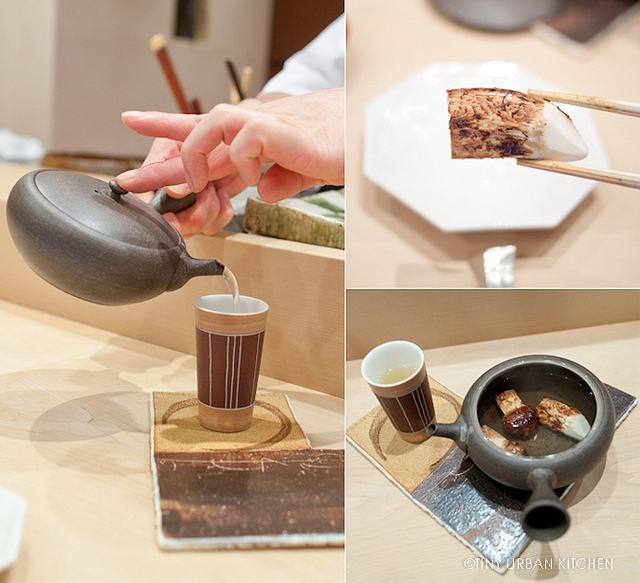
7. Matsutaki Soup (mushroom)
Have you ever had Matsutaki mushrooms? They grow at the foot of pine trees and are hard to find, thus very expensive. Mitani-san made a simple yet delicious broth out of the matsutaki mushrooms. It was earthy, clean, and extremely flavorful. It was a perfect "cleansing" mid-course between all the different seafood dishes. I absolutely loved it, and savored every sip of the golden nectar.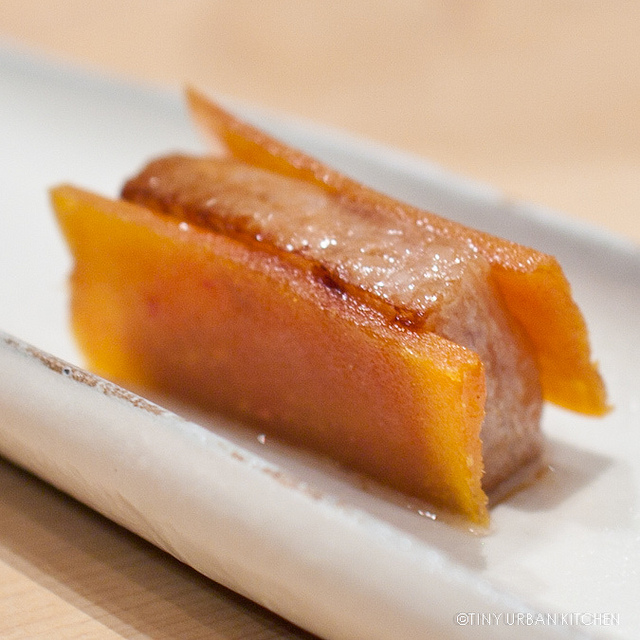
8. Otoro wth Karasumi (from Taiwan)
If you're from Taiwan, you've probably had Karasumi before. Called 烏魚子 in Chinese (wūyúzi), it is the dried and salted roe sac from a fish called the mullet. According to my aunt and uncle, Taiwan is one of the few places that can harvest this because the fish migrate near Taiwan right around the time when the roe is large and ready for harvest.
In this case, the otoro (fatty tuna) is sandwiched between two slices of the Taiwanese fish roe. Karasumi is salty, flavorful, and very rich in flavor. The idea of sandwiching otoro in the middle was quite new to me. The entire bite was rich, salty, and very satisfying. I could imagine it going down really well with sake or beer!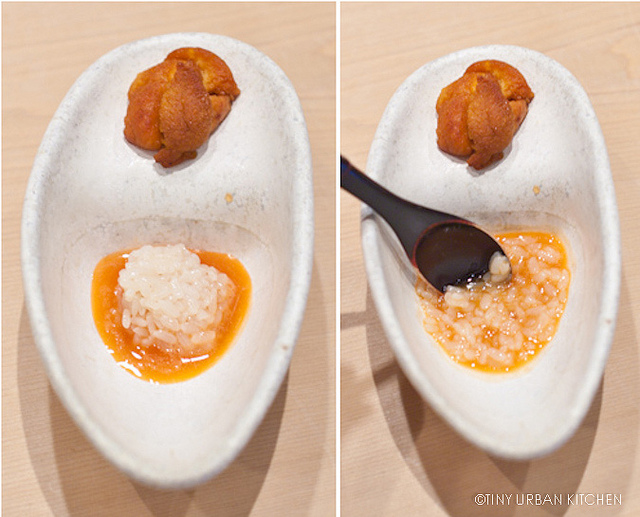
9. Uni + Rice + Ikura Sauce
Mitani-san was quite particular in teaching me how to eat this next dish. First mix up the ikura sauce (bright orange liquid made from mashed salmon roe) with the rice. Enjoy half of each portion separately. Then mix in the uni (sea urchin) with the rice and taste the entire mixture together.
Wow.
I was floored by how delicious the ikura sauce tasted. I asked Mitani-san whether he had added hints of orange or some other bright citrus flavoring, and he strongly said "noooooo . . . only a bit of soy sauce!" The beauty of the ikura flavor alone was undeniable. It was delicious with the rice, and also interesting with the addition of uni (the second "part" of the dining experience). Again, this top notch ikura hails from Hokkaido, the northern part of Japan.
The Sushi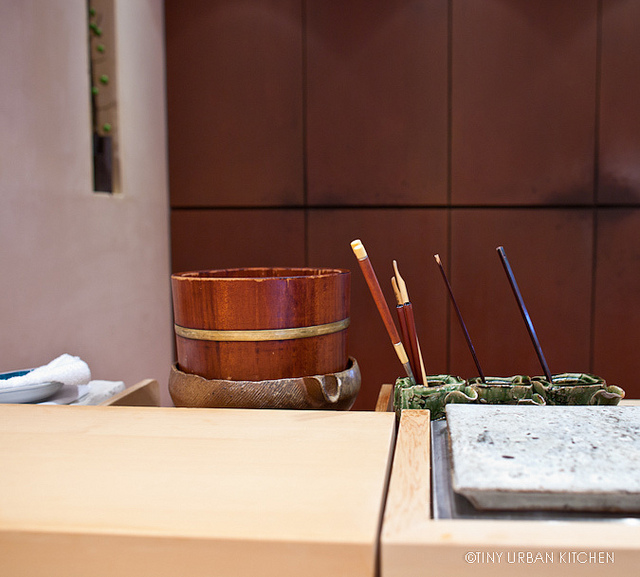
The first part of the tasting had ended, and now the big tub of rice came out. Mitani-san was about to start making sushi. I guess you never know what kind of sushi you're going to get if you're coming as a visitor for the first time. Unlike a true omakase, where the sushi chef knows you and can make things according to your liking, here he just gave me whatever he fancied.
This meal turned out to focus quite heavily on edomae sushi, the traditional Tokyo-style sushi that emerged in the late 1800's in Japan. Edomae literally means "in front of Edo", which refers to fish that come from Tokyo Bay. In the olden days, Tokyo was called "Edo," and raw fish over vinegared rice became a popular item sold on the streets near the fish market in Tokyo. Because of the lack of refrigeration back then, raw fish was sometimes cured with soy sauce or vinegar in order for it to keep longer. 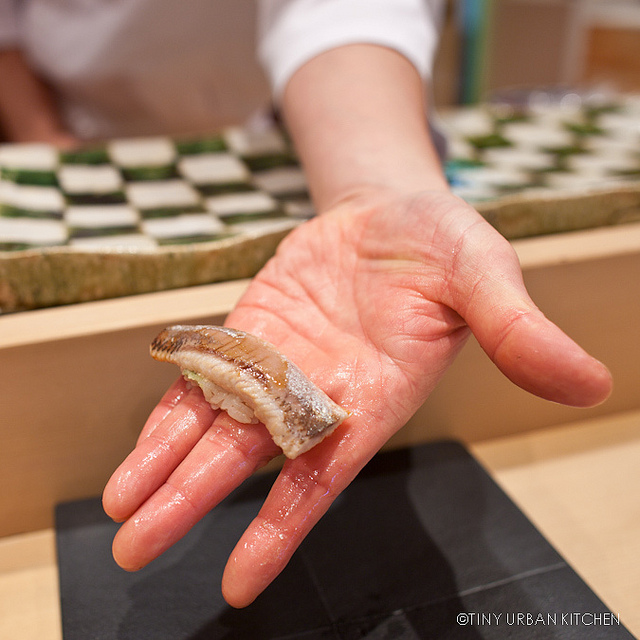
10. Sardine
This first sardine was definitely cured in some sort of edomae fashion. It was very rich and fatty in that melt-in-your-mouth kind of way. I found it to be just a tad salty, but overall it was quite good.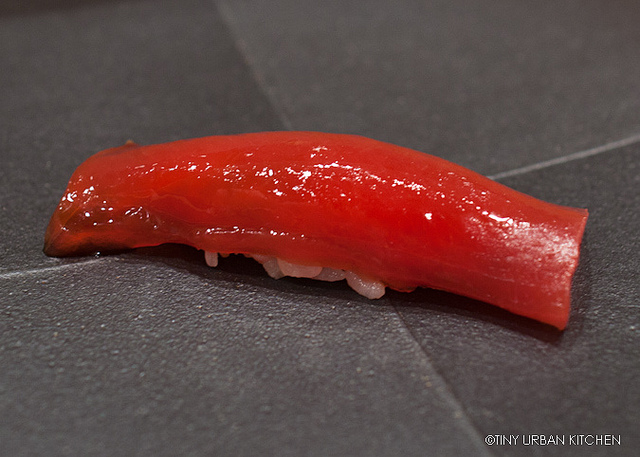
11. Maguro akami zuke
Similarly, this fiery red piece of tuna (the lean cut, akami) was again cured with soy sauce or something salty in the edomae tradition (zuke style).Unfortunately, I did not enjoy this piece much, thinking it way too salty.
12. Hirame (not pictured)
This white fish (fluke) had been pressed between two layers of kombu. The fish was tougher, and (again) cured. Thought not one of my favorites, I still thought it was quite good.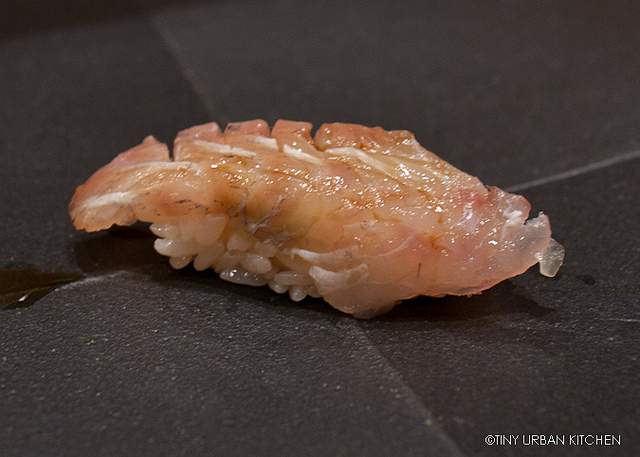
13. Kohada
This fish (gizzard shad) is also slightly vinegared. The rice sort of falls apart and you have to work hard to eat it. Mitani-san makes you eat with your hands. I asked him why the rice was brownish. "Is there soy sauce in the rice?
"No," he replied, "I use red vinegar in the rice instead."
Naruhodo! (I see!)
14. Toyama (white shrimp)
The next course (not pictured) was a raw, white shrimp known as toyama. I found it to be creamy, flavorful, and quite good, but (again) too salty! (Do you see a trend here? Maybe I'm thankful for the invention of refrigeration, which allows us to eat raw but not too salty fish!)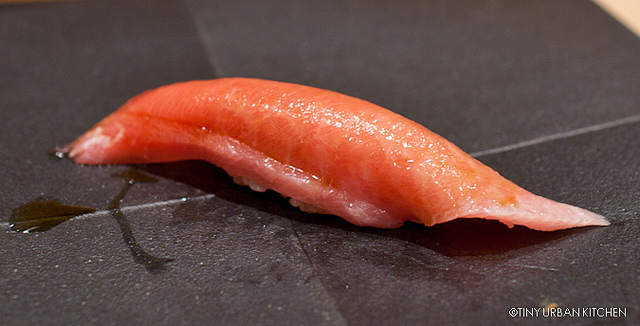
15. Chutoro
Fatty tuna belly is one of my favorite things to eat in the world, and I was so excited when I saw him take it out. Though this piece was not too salty, I found that it had just a tad of "stringyness", which you usually don't experience at top-notch sushi places. He also added a strong wasabi component, probably to offset the fattiness of the fish.
16. Ika (squid) (not pictured)
Although I don't typically like squid sushi in the U.S., I love it in Japan. This particular piece was creamy, reasonably good, but (again) just a bit too salty. I didn't think it was as good as the one from Daisan Harumi (which was excellent). Compared to others we've had in Japan, it was quite average (though it still beats US versions hands down).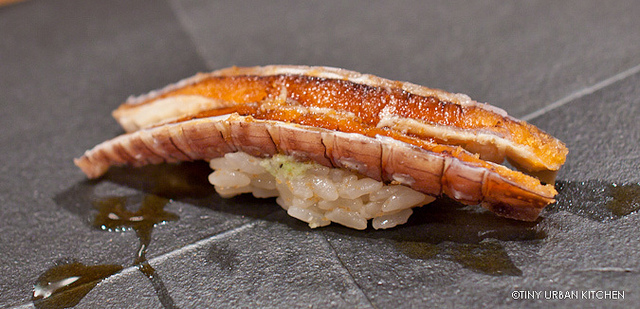
17. Shako
Shako, known as mantis shrimp in English, are actually not shrimp at all. Instead, they are sea crustaceans that are named "mantis shrimp" because the look like a cross between a shrimp and a praying mantis. When cooked, they look grayish and taste sort of rubbery. This interesting edomae rendition is cured in salt and filled with roe! It's also presented dramatically, served split in half to show off the bright, orange roe.
18. Anago Sushi
Unlike unagi, which is freshwater eel, anago is the salt water cousin. This particular piece was rich, tender, and piping hot! Though the hot, flaky eel had great flavor, the pieces were unevenly salted. In general, I wished for a greater rice to eel ratio. Although the anago was excellent quality, overall, I felt that Daisan Harumi makes a superior version of this one.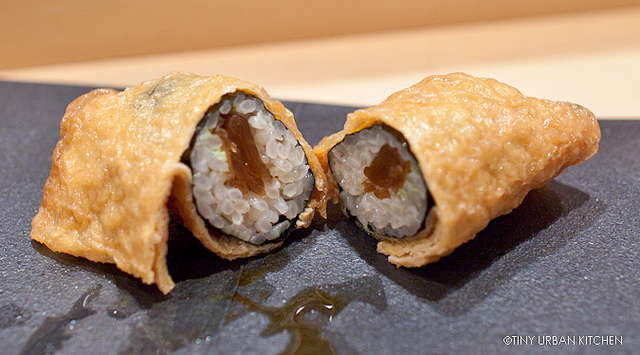
19. Kampio Inarizushi and Maki
Near the end of these omakase meals, it's not uncommon to end with some sort of maki "filler." Wrapping a normal maki with the tofu skins typically used in inarizushi was an interesting twist and worked quite well. 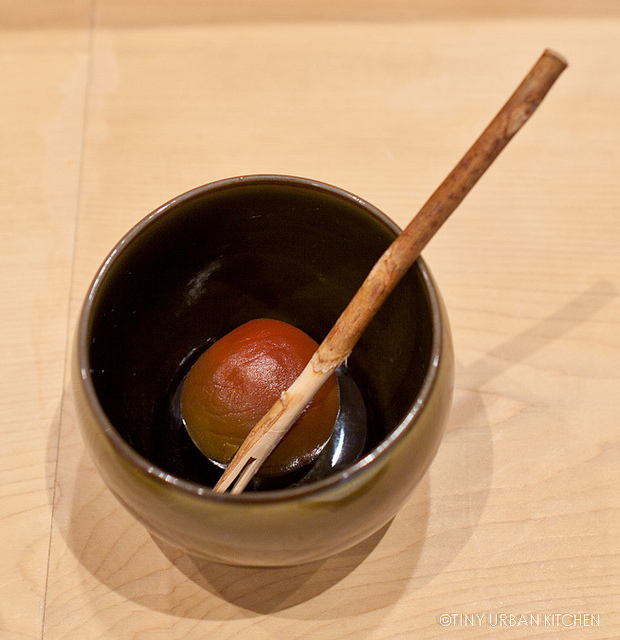
20. Ume (dessert)
Although I am typically not a huge fan of Japanese plum (ume), this was the best ume I had ever eaten! Unlike most pickled ume I've had, this one was not uncomfortably sour. It just had a slight tartness and was actually quite sweet and full of lovely fruit flavors. If all ume tasted like this, I would love ume!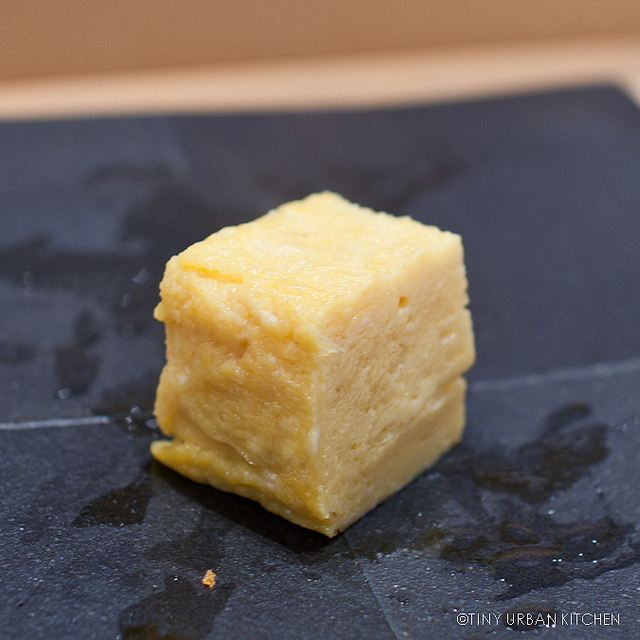
21. Tamago
Some say you can judge how good a sushi chef is by the quality of his tamago (sweet, steamed egg). This egg omelet was steaming hot, creamy, slightly sweet, and had several beautiful layers. I thought it was better than the one at Daisun Harumi but not as good as the epic one from Sushi Kanesaka.
Overall, it was a very enjoyable meal. I was more impressed with the first half of the meal, where creative combinations, unusual yet incredible soups, and high quality ingredients stood out to me. Although the edomae inspired second half was also good, I generally found the cured fish to be a bit too salty for my tastes.
In general, however, there were definitely some aspects of this meal that I thought were outstanding. My favorite courses (the ones I still think about to this day) would be the matsutake soup, the uni + ikura + rice, and the uni soup.
Prices are not cheap. My entire meal (which was just lunch!) was somewhere between $150 and $200 USD (all inclusive). I guess for 21 courses maybe it's not horrendous, but it's definitely a splurge type meal. I basically had to tell him to stop when I got to the point where I felt like I was about to explode. You can always tell him you want to stop earlier!
Related Posts
Post Quake Japan
Kago
Daisan Harumi
Tempura Kondo
All Rights Reserved


